Peugeot 307 SW 2003 Owners Manual
Manufacturer: PEUGEOT, Model Year: 2003, Model line: 307 SW, Model: Peugeot 307 SW 2003Pages: 183, PDF Size: 2.31 MB
Page 91 of 183
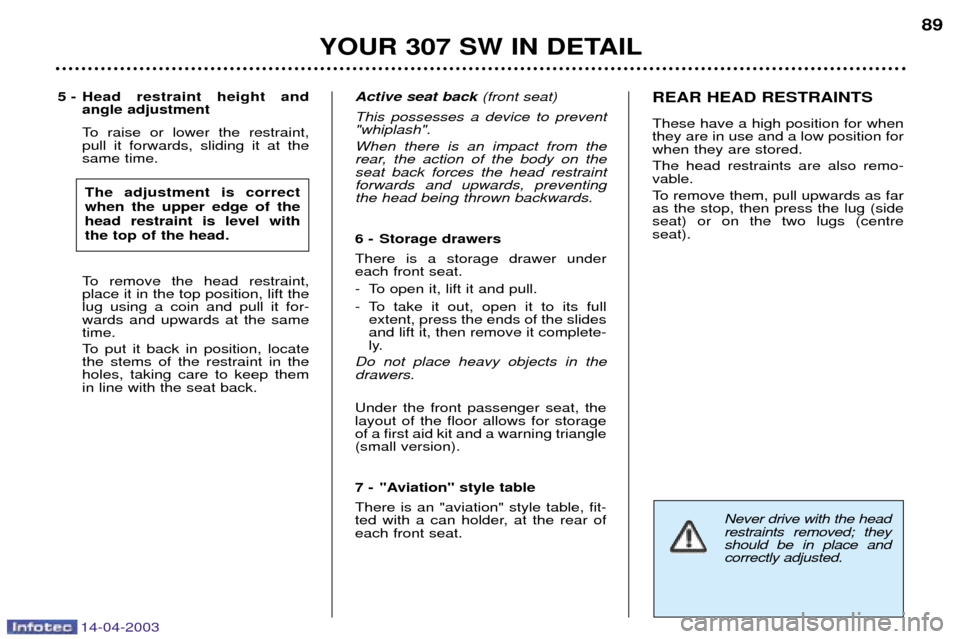
14-04-2003
Never drive with the head restraints removed; theyshould be in place andcorrectly adjusted.
5 - Head restraint height andangle adjustment
To raise or lower the restraint, pull it forwards, sliding it at thesame time.
To remove the head restraint, place it in the top position, lift thelug using a coin and pull it for-wards and upwards at the sametime.
To put it back in position, locate the stems of the restraint in theholes, taking care to keep themin line with the seat back. Active seat back
(front seat)
This possesses a device to prevent"whiplash". When there is an impact from the
rear, the action of the body on theseat back forces the head restraintforwards and upwards, preventingthe head being thrown backwards.
6 - Storage drawers There is a storage drawer under each front seat.
- To open it, lift it and pull.
- To take it out, open it to its full extent, press the ends of the slides and lift it, then remove it complete-
ly.
Do not place heavy objects in thedrawers. Under the front passenger seat, the layout of the floor allows for storageof a first aid kit and a warning triangle(small version).
7 - "Aviation" style table There is an "aviation" style table, fit-
ted with a can holder, at the rear ofeach front seat. REAR HEAD RESTRAINTS These have a high position for when they are in use and a low position forwhen they are stored. The head restraints are also remo- vable.
To remove them, pull upwards as far as the stop, then press the lug (sideseat) or on the two lugs (centreseat).
YOUR 307 SW IN DETAIL
89
The adjustment is correct when the upper edge of thehead restraint is level withthe top of the head.
Page 92 of 183
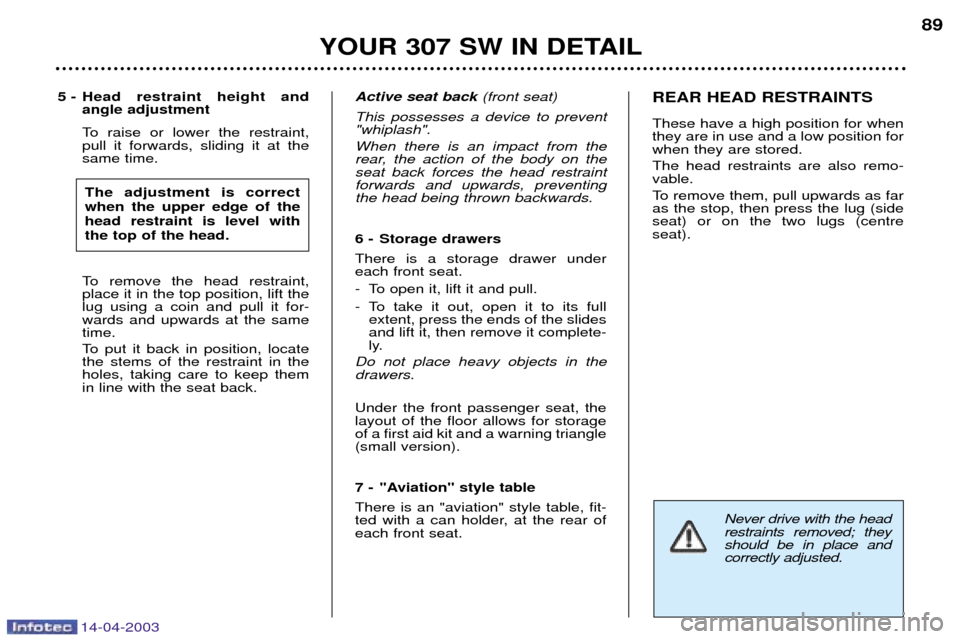
14-04-2003
Never drive with the head restraints removed; theyshould be in place andcorrectly adjusted.
5 - Head restraint height andangle adjustment
To raise or lower the restraint, pull it forwards, sliding it at thesame time.
To remove the head restraint, place it in the top position, lift thelug using a coin and pull it for-wards and upwards at the sametime.
To put it back in position, locate the stems of the restraint in theholes, taking care to keep themin line with the seat back. Active seat back
(front seat)
This possesses a device to prevent"whiplash". When there is an impact from the
rear, the action of the body on theseat back forces the head restraintforwards and upwards, preventingthe head being thrown backwards.
6 - Storage drawers There is a storage drawer under each front seat.
- To open it, lift it and pull.
- To take it out, open it to its full extent, press the ends of the slides and lift it, then remove it complete-
ly.
Do not place heavy objects in thedrawers. Under the front passenger seat, the layout of the floor allows for storageof a first aid kit and a warning triangle(small version).
7 - "Aviation" style table There is an "aviation" style table, fit-
ted with a can holder, at the rear ofeach front seat. REAR HEAD RESTRAINTS These have a high position for when they are in use and a low position forwhen they are stored. The head restraints are also remo- vable.
To remove them, pull upwards as far as the stop, then press the lug (sideseat) or on the two lugs (centreseat).
YOUR 307 SW IN DETAIL
89
The adjustment is correct when the upper edge of thehead restraint is level withthe top of the head.
Page 93 of 183
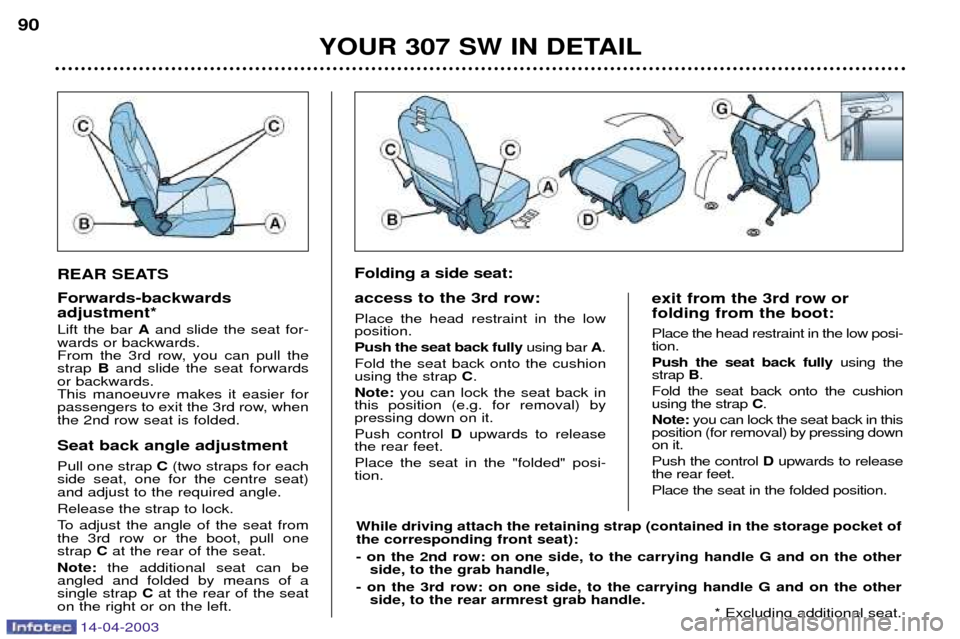
14-04-2003
REAR SEATS Forwards-backwards adjustment* Lift the bar Aand slide the seat for-
wards or backwards.
From the 3rd row, you can pull thestrap Band slide the seat forwards
or backwards.This manoeuvre makes it easier for
passengers to exit the 3rd row, whenthe 2nd row seat is folded.
Seat back angle adjustment Pull one strap C(two straps for each
side seat, one for the centre seat) and adjust to the required angle. Release the strap to lock.
To adjust the angle of the seat from the 3rd row or the boot, pull onestrap Cat the rear of the seat.
Note: the additional seat can be
angled and folded by means of asingle strap Cat the rear of the seat
on the right or on the left. Folding a side seat: access to the 3rd row: Place the head restraint in the low position. Push the seat back fully
using bar A.
Fold the seat back onto the cushion using the strap C.
Note: you can lock the seat back in
this position (e.g. for removal) bypressing down on it. Push control Dupwards to release
the rear feet.Place the seat in the "folded" posi- tion. exit from the 3rd row or folding from the boot: Place the head restraint in the low posi- tion. Push the seat back fully
using the
strap B.
Fold the seat back onto the cushion using the strap C.
Note: you can lock the seat back in this
position (for removal) by pressing downon it. Push the control Dupwards to release
the rear feet.Place the seat in the folded position.
YOUR 307 SW IN DETAIL
90
While driving attach the retaining strap (contained in the storage pocket of the corresponding front seat): - on the 2nd row: on one side, to the carrying handle G and on the other
side, to the grab handle,
- on the 3rd row: on one side, to the carrying handle G and on the other side, to the rear armrest grab handle. * Excluding additional seat.
Page 94 of 183

14-04-2003
YOUR 307 SW IN DETAIL91
Centre seat table position Place the head restraint in the low position. Fold the seat back onto the cushion using the strap C.
You now have a small table with fourcan holders, two pen holders and a
document holder.
Folding the centre seat Place the head restraint in the low position. Push the seat back full y using the
bar Aor the strap B.
Fold the seat back onto the cushion using the strap C.
Note: you can lock the seat back in
this position (for removal) by pres-sing down on it. Push control Dupwards to release
the rear feet.Place the seat in the folded position. While driving, attach the retaining strap (contained in the storagepocket of one of the front seats)on one side to the carrying handleG and on the other side, to thegrab handle. Folding an additional seat Place the head restraint in the low position. Pull the strap
C(at the rear of the
seat to the right or to the left) back- wards then press on the seat back torelease it, while continuing to pull thestrap. Fold the seat back onto the seat cushion. Note: you can lock the seat back in
this position (for removal) by pres- sing down on it. Push the two levers Eupwards to
unlock the rear feet.Place the seat in the folded position.While driving, attach the retaining strap (contained in the storagepocket of the additional seat) onone side to the carrying handle Gand on the other side, to the reararmrest grab handle.
Page 95 of 183
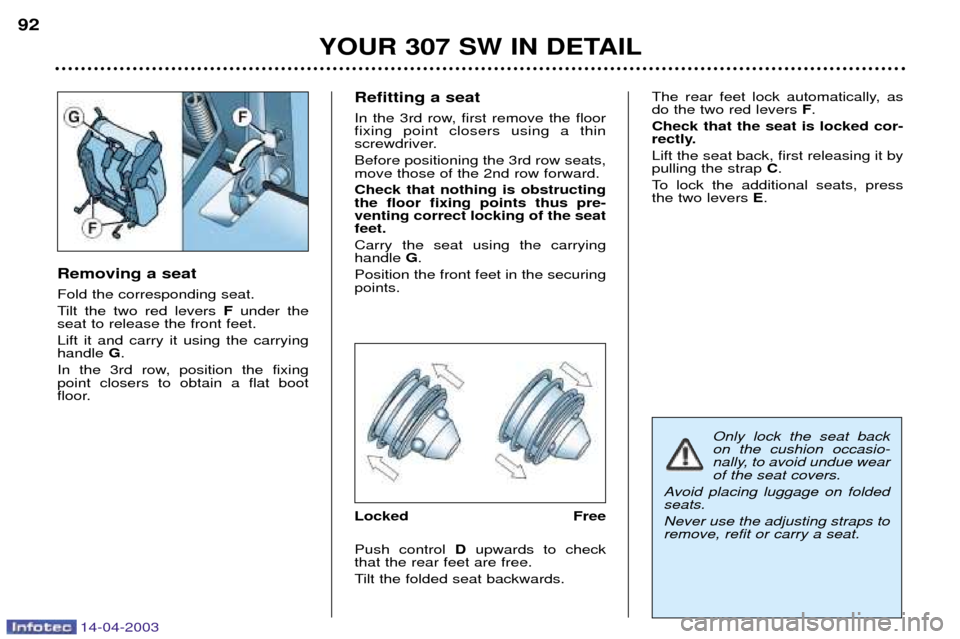
14-04-2003
Removing a seat Fold the corresponding seat.
Tilt the two red levers Funder the
seat to release the front feet.Lift it and carry it using the carrying handle G.
In the 3rd row, position the fixingpoint closers to obtain a flat boot
floor. Refitting a seat
In the 3rd row, first remove the floor fixing point closers using a thin
screwdriver. Before positioning the 3rd row seats, move those of the 2nd row forward. Check that nothing is obstructing the floor fixing points thus pre-venting correct locking of the seatfeet. Carry the seat using the carrying handle
G.
Position the front feet in the securingpoints.
Locked Free Push control Dupwards to check
that the rear feet are free.
Tilt the folded seat backwards. The rear feet lock automatically, as do the two red levers
F.
Check that the seat is locked cor-
rectly. Lift the seat back, first releasing it by pulling the strap C.
To lock the additional seats, pressthe two levers E.
YOUR 307 SW IN DETAIL
92
Only lock the seat back on the cushion occasio-
nally, to avoid undue wearof the seat covers.
Avoid placing luggage on foldedseats. Never use the adjusting straps to remove, refit or carry a seat.
Page 96 of 183

14-04-2003
YOUR 307 SW IN DETAIL93
Rules for transporting children on the front passenger seat** Children under the age of 10 must not travel in the forwards facingposition, unless the rear seats arealready occupied by other childrenor the rear seats cannot be used(absent or folded). In this case,adjust the front passenger seat tothe most rearward position and armthe passenger air bag. The rearwards facing position is per- mitted from birth to 13 kg or 18 kg. Inthis position, it is essential to disarmthe passenger air bag.
GENERAL POINTS RELATING TO CHILD SEATS Although one of PEUGEOT's main criteria when designing your vehicle, the safe- ty of your children also depends on you.
For maximum safety, please follow these precautions:
- Since 1992, all children under the age of 10 must travel in approved child
seats* suited to their weight , on seats fitted with a seat belt.
In order to recognise a child seat which conforms to current legislation, check
that it bears an orange label indicating the weight range for its use and its approval number .
- A child weighing less than 9 kg must travel in the rearwards facing posi-
tion both in the front and in the rear. PEUGEOT recommends that chil-dren should travel in the "rearwards facing" position up to the age of two.
- Statistically, the safest seats in your vehicle for the transportation of chil-dren are the rear seats .
- If a child is travelling on a booster seat, check that the lap section of the seat belt passes over the child's thighs correctly. The chest section of the seat belt must be positioned on the child's shoulder without touching the neck.
PEUGEOT recommends that you use a booster seat with a back, fitted with aseat belt guide.
- Remember to fasten the seat belt or the child seat harness keeping the slack
in relation to the child's body to a minimum , even for short journeys.
* According to current legislation in the country.
** Consult the relevant administration in your country for information regarding the rules for transporting children on the front passenger seat.
Page 97 of 183

14-04-2003
ISOFIX MOUNTINGS The two rear side seats of your vehicle are fitted with ISOFIX moun-
tings . These are two rings located
between the seat back and the seatcushion. The ISOFIX child seats are fitted
with two locks which are secured
easily on these rings. All this guaran-tees reliable, safe and fast fitting. The ISOFIX child seat approved forPeugeot vehicles and sold byPeugeot dealers is the
ISOFIX
KIDDY* child seat. It can be fitted in
the "rear facing" position (when theside seats are recentred) from birthto 13 kg and in the "forwards facing"position from 9 to 18 kg. In the front, in the "rear facing" posi- tion, the front passenger seat mustbe moved as far forward as possibleso that the body of the child seat is incontact with or as close as possibleto the fascia.
In the rear, in the "forwards facing" position, it is imperative that the frontpassenger seat is in the mid-way
position on the runner, seat backupright.
YOUR 307 SW IN DETAIL
94
The ISOFIX KIDDY seat can also be installed on a 2nd row side seatwhich has been positioned in the 3rd
row. In ths case, the ISOFIX KIDDYseat must be in the "rear facing"position, the body supported on theseat back of the corresponding 2ndrow seat. This seat can also be used on seats not fitted with ISOFIX mountings. Inthis case it is compulsory to attach itto the vehicle's seat by means of thethree-point seat belt for the "rearfacing" and "forwards facing" posi-tions. Refer to the "Summary table for fit- ting child seats".
When the ISOFIX KIDDY seat is fitted in the "rear facing" positionon the front passenger seat, it isimperative that that passenger airbag be disarmed. Otherwise there is a risk the child could be seriously injured or evenkilled due to deployment of the airbag. Follow the instructions for fitting the child seat in the seat manu-facturer's instruction booklet.
* You can only fit ISOFIX child seats
approved by PEUGEOT and sold
by PEUGEOT dealers on yourvehicle's ISOFIX mountings.
Page 98 of 183

14-04-2003
CHILD SEATS RECOMMENDED BY PEUGEOT
In addition to the ISOFIX child seats, PEUGEOT offers a complete range of child seats which are secured using the seat belt: Group 0+: from birth to 13 kg
L1 - "Britax Babysure": installed in the rear-facing position in the front or in the rear using a three-point seat belt.In the front, it is compulsory to disarm the passenger air bag and the passenger seat must be adjusted to the "mid-way" position on the runner.
Group 1: from 9 to 18 kg
L2 - "Ršmer Prince": installed in the rear using a two or three-point seat belt. For the safety of your child, the seat and the restraining cushion must never be separated.
Group 2: from 15 to 25 kg
L3 - "Ršmer Vario'': installed in the rear with a two or three-point seat belt.
YOUR 307 SW IN DETAIL 95
Page 99 of 183
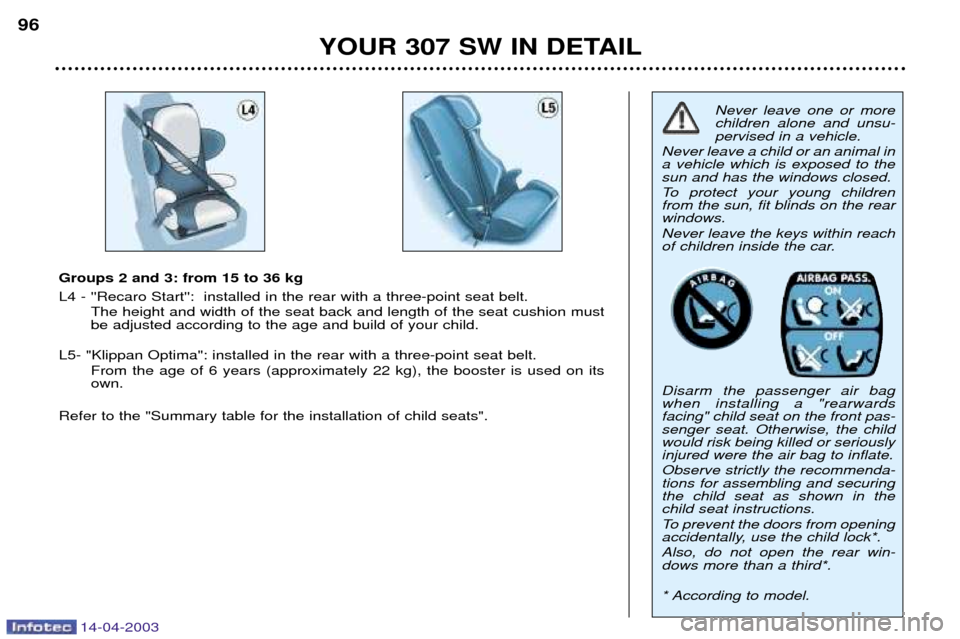
14-04-2003
YOUR 307 SW IN DETAIL
96
Never leave one or more children alone and unsu-pervised in a vehicle.
Never leave a child or an animal ina vehicle which is exposed to thesun and has the windows closed.
To protect your young children from the sun, fit blinds on the rearwindows. Never leave the keys within reach
of children inside the car. Disarm the passenger air bag when installing a "rearwardsfacing" child seat on the front pas-senger seat. Otherwise, the childwould risk being killed or seriouslyinjured were the air bag to inflate. Observe strictly the recommenda- tions for assembling and securingthe child seat as shown in thechild seat instructions.
To prevent the doors from opening
accidentally, use the child lock*. Also, do not open the rear win- dows more than a third*.
* According to model.
Groups 2 and 3: from 15 to 36 kg
L4 - ''Recaro Start'': installed in the rear with a three-point seat belt. The height and width of the seat back and length of the seat cushion must be adjusted according to the age and build of your child.
L5- "Klippan Optima": installed in the rear with a three-point seat belt. From the age of 6 years (approximately 22 kg), the booster is used on itsown.
Refer to the "Summary table for the installation of child seats".
Page 100 of 183
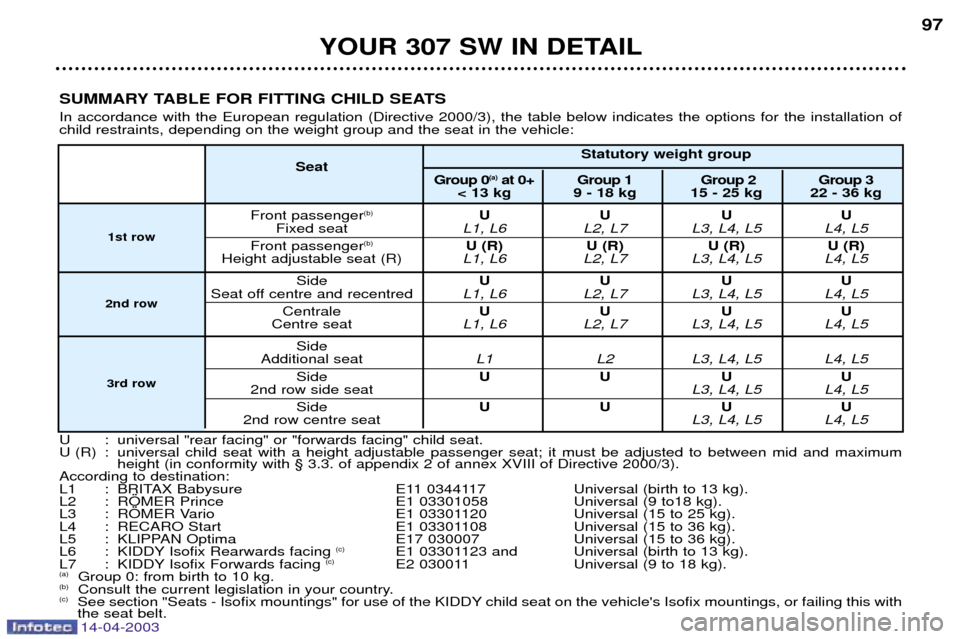
14-04-2003
YOUR 307 SW IN DETAIL97
SUMMARY TABLE FOR FITTING CHILD SEATS In accordance with the European regulation (Directive 2000/3), the table below indicates the options for the installation of child restraints, depending on the weight group and the seat in the vehicle:
U : universal "rear facing" or "forwards facing" child seat.
U (R) : universal child seat with a height adjustable passenger seat; it must be adjusted to between mid and maximum height (in conformity with ¤ 3.3. of appendix 2 of annex XVIII of Directive 2000/3).
According to destination:
L1 : BRITAX Babysure E11 0344117 Universal (birth to 13 kg).
L2 : R…MER Prince E1 03301058 Universal (9 to18 kg).
L3 : R…MER Vario E1 03301120 Universal (15 to 25 kg).
L4 : RECARO Start E1 03301108 Universal (15 to 36 kg).
L5 : KLIPPAN Optima E17 030007 Universal (15 to 36 kg).
L6 : KIDDY Isofix Rearwards facing (c)
E1 03301123 and Universal (birth to 13 kg).
L7 : KIDDY Isofix Forwards facing (c)
E2 030011 Universal (9 to 18 kg).
(a) Group 0: from birth to 10 kg.
(b) Consult the current legislation in your country.
(c) See section "Seats - Isofix mountings" for use of the KIDDY child seat on the vehicle's Isofix mountings, or failing this with the seat belt. Statutory weight group
Seat Group 0(a)
at 0+ Group 1 Group 2 Group 3
< 13 kg 9 - 18 kg 15 - 25 kg 22 - 36 kg
Front passenger (b)
UU UU
Fixed seat L1, L6 L2, L7 L3, L4, L5 L4, L5
Front passenger (b)
U (R) U (R) U (R) U (R)
Height adjustable seat (R) L1, L6 L2, L7 L3, L4, L5 L4, L5
Side UU UU
Seat off centre and recentred L1, L6 L2, L7 L3, L4, L5 L4, L5
Centrale UU UU
Centre seat L1, L6 L2, L7 L3, L4, L5 L4, L5
Side
Additional seat L1 L2 L3, L4, L5 L4, L5
Side UU UU
2nd row side seat L3, L4, L5 L4, L5
Side UU UU
2nd row centre seat L3, L4, L5 L4, L5
1st row
2nd row
3rd row